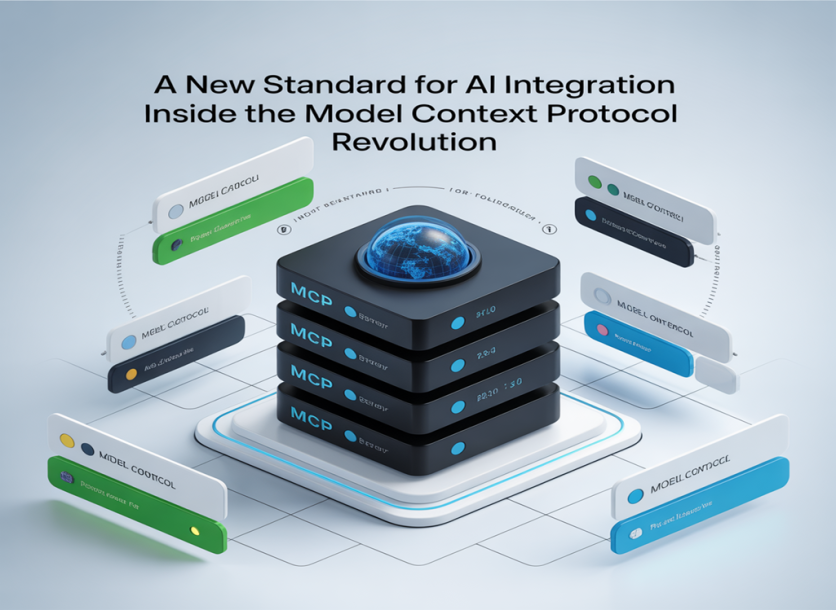
In the fast-evolving world of Agentic AI, where Large Language Models (LLMs) are rapidly advancing, seamless integration with external tools and data sources remains a key challenge. Imagine an AI that can seamlessly connect to any tool or data source, just like plugging a USB device into your computer. This is the promise of the Model Context Protocol (MCP), a groundbreaking standard poised to redefine how artificial intelligence integrates with the digital world. Narendra Kumar Reddy Choppa, a Senior IT Solutions Analyst, explores this very challenge and its transformative solution in a comprehensive examination of the Model Context Protocol (MCP). His insights anchor a vision of an interconnected, context-aware AI ecosystem, now beginning to materialize.
Solving the AI Integration Puzzle
For years, developers have struggled to connect AI models, like large language models (LLMs), to API's, external tools, and data sources. Each connection required custom code, leading to isolated systems, wasted resources, and repetitive work. MCP acts like a universal adapter, similar to how USB-C simplified hardware connections. One of the most impactful changes, according to Choppa, is MCP offering a standardized way to integrate tools, which eliminates the need for custom solutions, significantly reducing complexity and development time.
The Building Blocks of MCP
MCP is built on a three-layered structure: transport, messaging, and semantic layers. Think of these as the foundation, communication channels, and meaning behind the data, respectively. This design allows each part to evolve independently without disrupting the system. Using advanced technologies, MCP enables real-time, two-way communication, making it easier for AI to interact with multiple tools dynamically. It also includes features for discovering and safely integrating new tools, ensuring reliability and security.
Security for Sensitive Applications
Security is critical for MCP, and Mr. Choppa emphasizes its robust design for fields like finance and healthcare. The protocol uses modern standards, such as OAuth 2.1, to control access, ensuring only authorized users and systems can interact with data. Features like activity logging, minimal access rights, and encrypted communications protect against unauthorized access, making MCP suitable for high-stakes environments.
Beyond Text: Multi-Modal Capabilities
As Mr. Choppa explains, MCP's ability to handle various data types—text, images, audio, and structured data—sets it apart. This means AI can do more than process words; it can analyze images, interpret audio, or manage complex datasets. For example, an AI agent could listen to a patient's symptoms, analyze medical images, and suggest a diagnosis, all within one system. This versatility opens doors to innovative applications across industries.
Impressive Efficiency Gains
In his analysis of organizations using MCP, Mr. Choppa highlights significant improvements: development time reduced by up to 70%, runtime latency decreased by 45%, and memory efficiency improved by 60%. Maintenance costs also dropped by 75% due to MCP's standardized interfaces, which adapt easily to changes in underlying systems. These gains are particularly valuable for real-time, multi-tool applications where performance is critical. For an e-commerce platform, this could mean an AI agent that instantly analyzes supply chain data, adjusts pricing based on competitor feeds, and updates product images simultaneously—tasks that previously required multiple, disconnected systems
Scaling from All Sizes
MCP scales effortlessly, from small startups to large enterprises. Its lightweight design suits resource-constrained environments, like edge AI devices, while its robust architecture supports complex organizational needs. Open-source software development kits (SDKs) in languages like Python, Java, and C# make MCP accessible to developers of all skill levels, fostering innovation in education, research, and industry.
Challenges and Future Directions
MCP isn't without hurdles. Integrating with older systems can require additional layers, potentially affecting performance. Adoption may also face resistance from companies using proprietary solutions, and training is needed to bring teams up to speed. However, a growing community is developing tools and sharing success stories to overcome these barriers. Future developments aim to enhance state management, dynamic tool discovery, and support for advanced data types like real-time video and spatial computing.
Democratizing AI Innovation
MCP's impact goes beyond technology. By simplifying integration, it empowers small teams and individual developers to create powerful AI applications without deep backend expertise. This democratization is evident in fields like education and healthcare, where MCP-powered AI agents are being rapidly developed and deployed, making advanced technology accessible to all.
In conclusion, the Model Context Protocol (MCP) isn't just a protocol; it's a paradigm shift that redefines how AI systems interact with the digital world. By enabling standardized, secure, and scalable tool integrations, it lays the foundation for richer, more capable AI applications. As the ecosystem matures and expands, the work of Narendra Kumar Reddy Choppa, along with contributions from other AI leaders, stands as a crucial element in shaping the future of Agentic AI.
ⓒ 2025 TECHTIMES.com All rights reserved. Do not reproduce without permission.





